Effects of Mixture Proportions and Levels of Vibration on the Physical Characteristics and Durability of Concrete Used in Korean Pavements
Abstract
:1. Introduction
2. Materials and Experiments
3. Results
3.1. Physical Properties
3.1.1. Bleeding Test
3.1.2. Float and Modified-Float Test
3.1.3. Mechanical Strengths
3.1.4. Density and Water Absorption
3.2. Durability
3.2.1. Freezing and Thawing
3.3. Pavement Performance
3.3.1. Skid Resistance and Surface Abrasion Resistance
3.3.2. Surface Displacement Variation (IRI Measurement)
4. Conclusions
- (1)
- Bleeding and finishability (i.e., float and modified float) results varied depending on the mixture proportions and vibration levels, and F-CON has easier finishability than CON, because the fly ash substituted in F-CON has spherical particles.
- (2)
- The strength of the samples varied depending on the different levels of vibration even in the samples with the same mixture proportions. In addition, the lower the vibration, the larger the standard deviation among samples, which indirectly indicated the difficulties involved in securing construction quality when a low level of vibration is applied. Furthermore, F-CON-L did not satisfy the concrete pavement strength criteria, which suggested that a low level of vibration induces many voids, lowering the strength.
- (3)
- The samples with low levels of vibration had relatively lower density and higher absorption than the other samples. Higher water absorption indicates that the sample has more voids, which may affect the strength and durability.
- (4)
- The samples with low levels of vibration were vulnerable to freezing and thawing, and F-CON-L did not satisfy the criteria suggested by KS F 2456. In addition, CON-L had lower freezing and thawing resistance than other samples, which suggested that the durability of the concrete could not be assured if inappropriate vibration was applied.
- (5)
- There was little difference in the performance tests (i.e., skid resistance, surface abrasion, and IRI) of the concrete pavements depending on mixture proportions and vibration levels. However, the samples with an intermediate level of vibration had a relatively higher performance than the other samples.
Author Contributions
Funding
Data Availability Statement
Acknowledgments
Conflicts of Interest
References
- MOLIT. Yearbook of Road Statistics; MOLIT: Sejong City, Republic of Korea, 2020. [Google Scholar]
- Yi, Z.-J.; Yang, Q.-G.; Tang, B.-M.; Wu, G.-X.; Zhou, Z.-X. A fundamental understanding to the failure of cement concrete pavement based on the concept of fracture mechanics. Road Mater. Pavement Des. 2002, 3, 261–280. [Google Scholar] [CrossRef]
- Yun, C.P.K.; Han, S.; Hong, S. Review of domestic and foreign concrete pavement mix desing for the development of cement concrete pavement (1)-Analysis of construction characteristics and improvement plan. Int. J. Highw. Eng. 2009, 11, 36–45. [Google Scholar]
- Park, H.-W.; Kim, D.-H.; Lee, J.-H.; Yum, W.-S.; Jeong, J.-H. Influence of mix properties of concrete slabs on the performance of airport pavements. Proc. Inst. Civ. Eng. Transp. 2023, 176, 3–13. [Google Scholar] [CrossRef]
- Tymkowicz, S.; Steffes, R.F. Vibration study for consolidation of Portland cement concrete. Transp. Res. Rec. 1997, 1574, 109–115. [Google Scholar] [CrossRef]
- Huang, Y.H. Pavement Analysis and Design; Pearson Prentice Hall: Upper Saddle River, NJ, USA, 2004; Volume 2. [Google Scholar]
- Mehta, P.K.; Monteiro, P.J. Concrete: Microstructure, Properties, and Materials; McGraw-Hill Education: New York, NY, USA, 2014. [Google Scholar]
- Ozyildirim, H.C.; Miller, R.E., Jr.; Chairman, S.; Bonikowsky, D.A.; Minnich, R.A.; Cumming, N.A.; Olsen, M.P.; Dolen, T.P.; Olson, L.D.; Ford, J.H. Guide for Consolidation of Concrete; ACI Committee: Farmington Hills, MI, USA, 1997. [Google Scholar]
- MOLIT. On-Site Construction Quality Management Handbook for Cement Concrete Pavement; MOLIT: Sejong City, Republic of Korea, 2009. [Google Scholar]
- Malvern Panalytical. X’pert HighScore Plus Software. Version 3.0; Malvern Panalytical: Malvern, UK, 2012. [Google Scholar]
- ICDD. Joint Committee on Powder Diffraction Standards (JCPDS)-International Centre for 398 Diffraction Data (ICDD). 2008. Available online: https://www.icdd.com/ (accessed on 1 August 2023).
- ASTM C 618; Standard Specification for Coal Fly Ash and Raw or Calcined Natural Pozzolan for Use in Concrete. ASTM: West Conshohocken, PA, USA, 2019.
- Korea Expressway Corporation. Highway Construction Material Quality Standards; Korea Expressway Corporation: Gimcheon, Republic of Korea, 2018. [Google Scholar]
- ASTM C 192; Standard Practice for Making and Curing Concrete Test Specimens in the Laboratory. ASTM: West Conshohocken, PA, USA, 2019.
- KS F 2414; Standard Test Method for Bleeding of Concrete. Korean Standard & Certification: Seoul, Republic of Korea, 2020.
- Cook, M.D.; Seader, J.N.; Ley, T.M.; Russell, B.W. Investigation of Optimized Graded Concrete for Oklahoma-Phase 2; Oklahoma Department of Transportation: Oklahoma City, OK, USA, 2015. [Google Scholar]
- ASTM C 109; Standard Test Method for Compressive Strength of Hydraulic Cement Mortars. ASTM: West Conshohocken, PA, USA, 2020.
- ASTM C 78; Standard Test Method for Flexural Strength of Concrete (Using Simple Beam with Third-Point Loading). ASTM: West Conshohocken, PA, USA, 2010.
- ASTM C 1585; Standard Test Method for Measurement of Rate of Absorption of Water by Hydraulic Cement Concretes. ASTM: West Conshohocken, PA, USA, 2011.
- ASTM C 12; Standard Test Method for Density, Relative Density (Specific Gravity), and Absorption of Coarse Aggregate. ASTM: West Conshohocken, PA, USA, 2007.
- KS F 2456; Standard Test Method for Resistance of Concrete to Rapid Frezzing and Thawing. Korean Standard & Certification: Seoul, Republic of Korea, 2018.
- ASTM C 779; Standard Test Method for Abrasion Resistance of Horizontal Concrete Surfaces. ASTM: West Conshohocken, PA, USA, 2019.
- KS F 2375; Standard Test Method for Measuring Surface Frictional Properties Using the British Pendulum Tester. Korean Standard & Certification: Seoul, Republic of Korea, 2016.
- Ravina, D.; Mehta, P.K. Properties of fresh concrete containing large amounts of fly ash. Cem. Concr. Res. 1986, 16, 227–238. [Google Scholar] [CrossRef]
- Sun, Z.; Young, C. Bleeding of SCC pastes with fly ash and GGBFS replacement. J. Sustain. Cem. Based Mater. 2014, 3, 220–229. [Google Scholar] [CrossRef]
- Eren, O.; Brooks, J.J.; Celik, T. Setting times of fly ash and slag-cement concretes as affected by curing temperature. Cem. Concr. Aggreg. 1995, 17, 11–17. [Google Scholar]
- Jeong, Y.; Park, H.; Jun, Y.; Jeong, J.-H.; Oh, J.E. Microstructural verification of the strength performance of ternary blended cement systems with high volumes of fly ash and GGBFS. Constr. Build. Mater. 2015, 95, 96–107. [Google Scholar] [CrossRef]
- Chindaprasirt, P.; Jaturapitakkul, C.; Sinsiri, T. Effect of fly ash fineness on compressive strength and pore size of blended cement paste. Cem. Concr. Compos. 2005, 27, 425–428. [Google Scholar] [CrossRef]
- Bouzoubaa, N.; Foo, S. Use of Fly Ash and Slag in Concrete: A Best Practice Guide; Materials and Technology Laboratory, MTL: Ottawa, ON, Canada, 2004; p. 16. [Google Scholar]
- Cho, Y.K.; Jung, S.H.; Choi, Y.C. Effects of chemical composition of fly ash on compressive strength of fly ash cement mortar. Constr. Build. Mater. 2019, 204, 255–264. [Google Scholar] [CrossRef]
- Yum, W.S.; Jeong, Y.; Yoon, S.; Jeon, D.; Jun, Y.; Oh, J.E. Effects of CaCl2 on hydration and properties of lime (CaO)-activated slag/fly ash binder. Cem. Concr. Compos. 2017, 84, 111–123. [Google Scholar] [CrossRef]
- Neville, A.M. Properties of Concrete; Longman: London, UK, 1995; Volume 4. [Google Scholar]
- KS F 2373; Standard Test Method for Measuring Pavement Roughness Using a 7.6 m Profilograph. Korean Standard & Certification: Seoul, Republic of Korea, 2010.
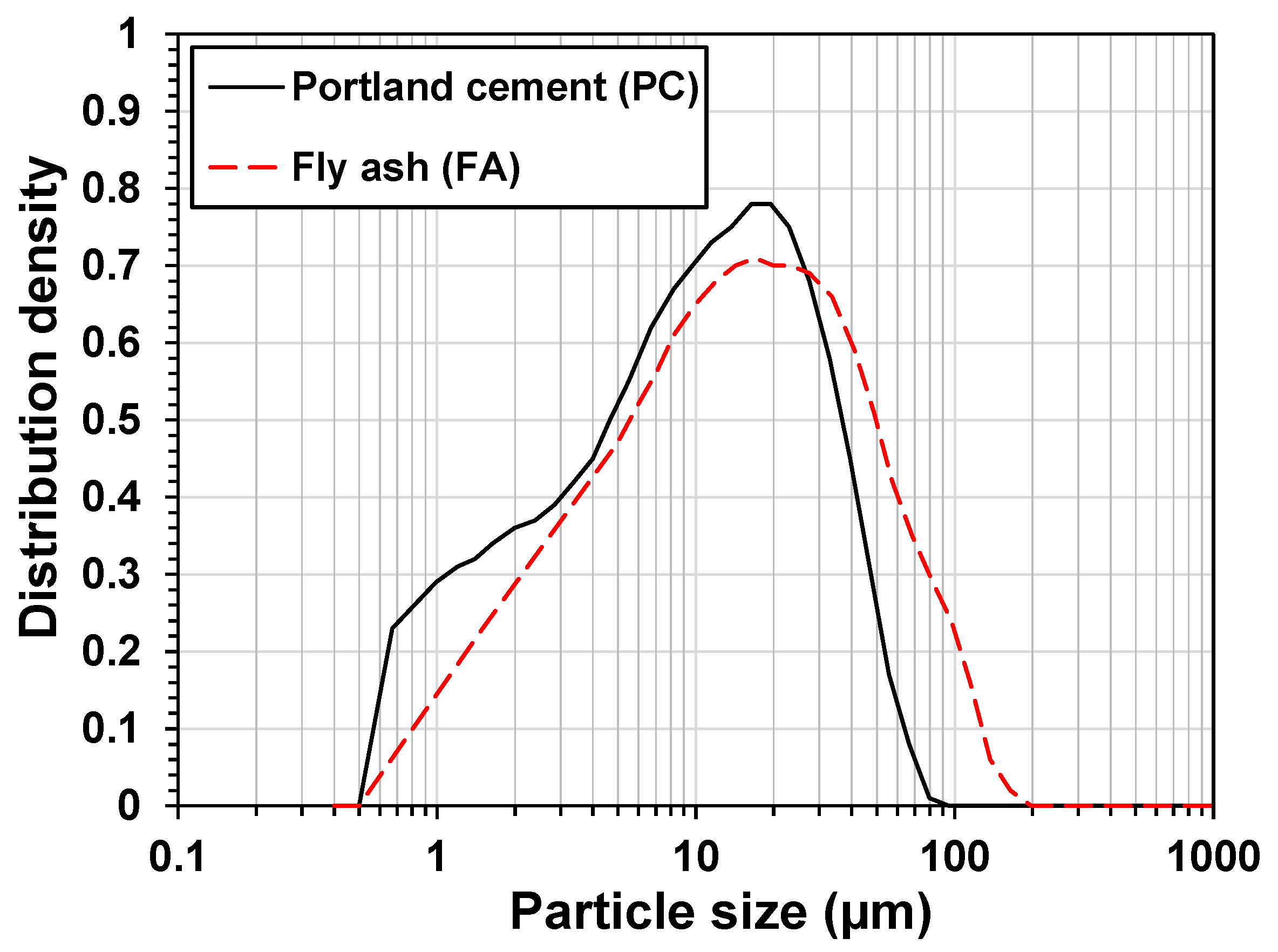
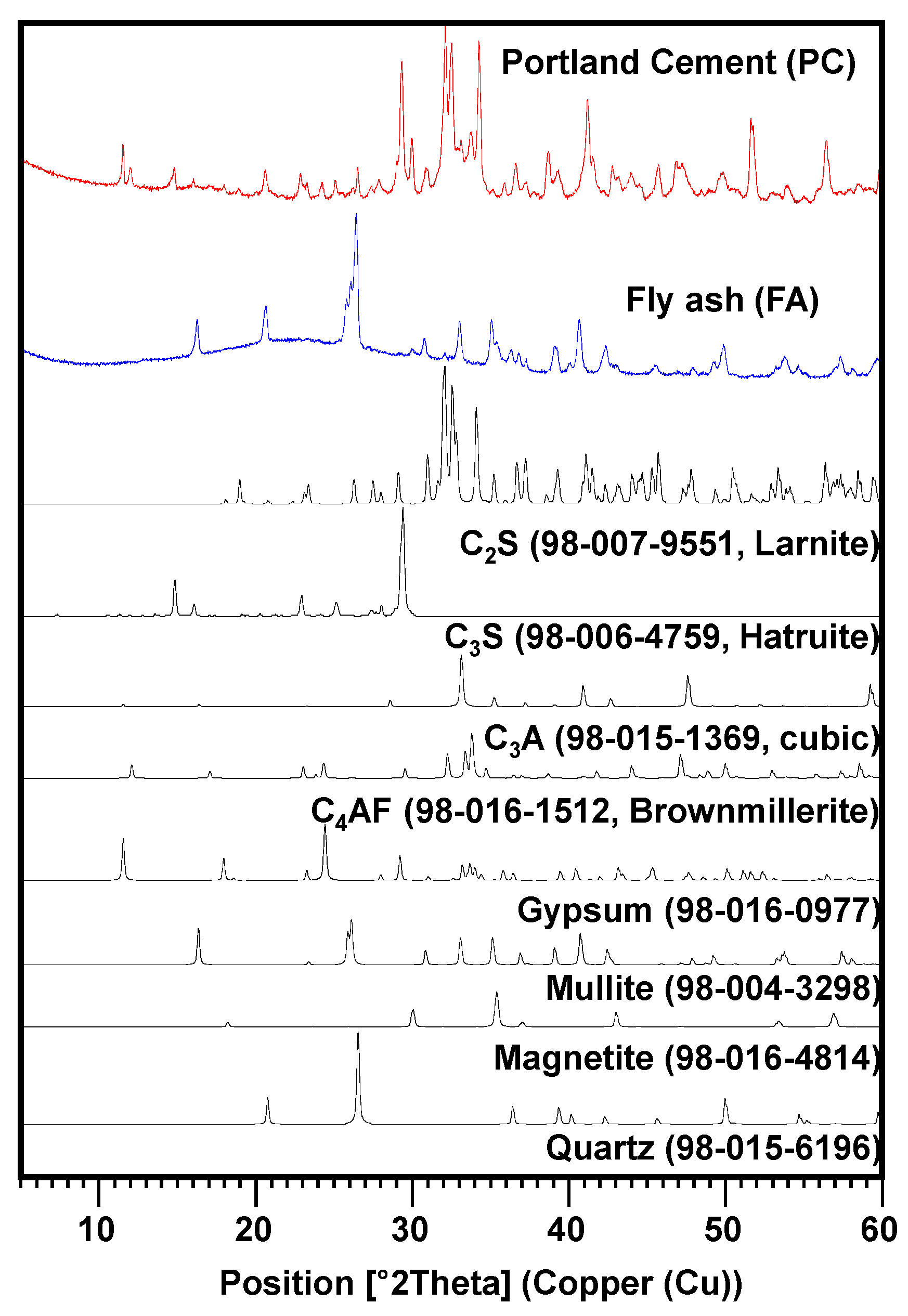



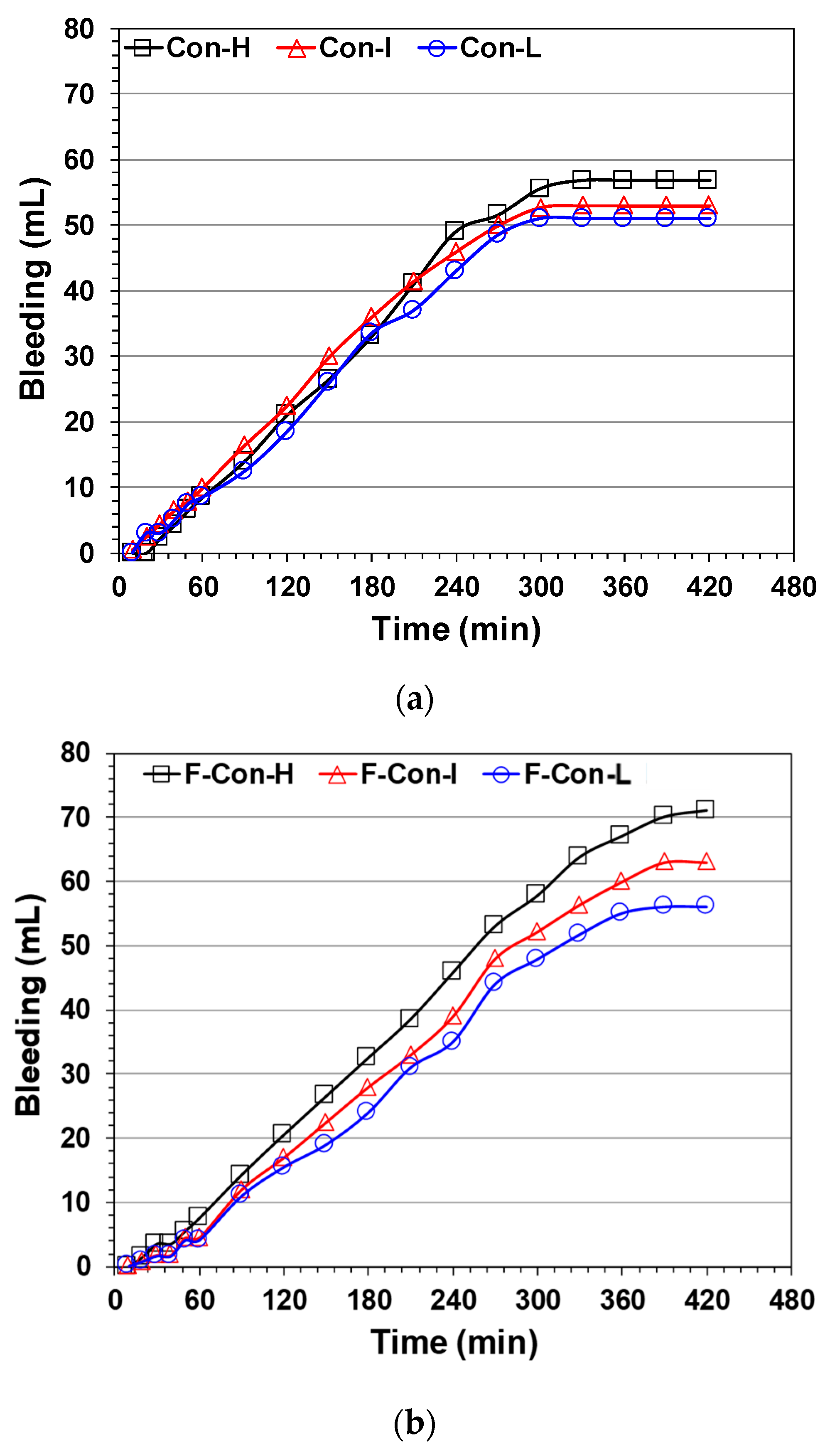
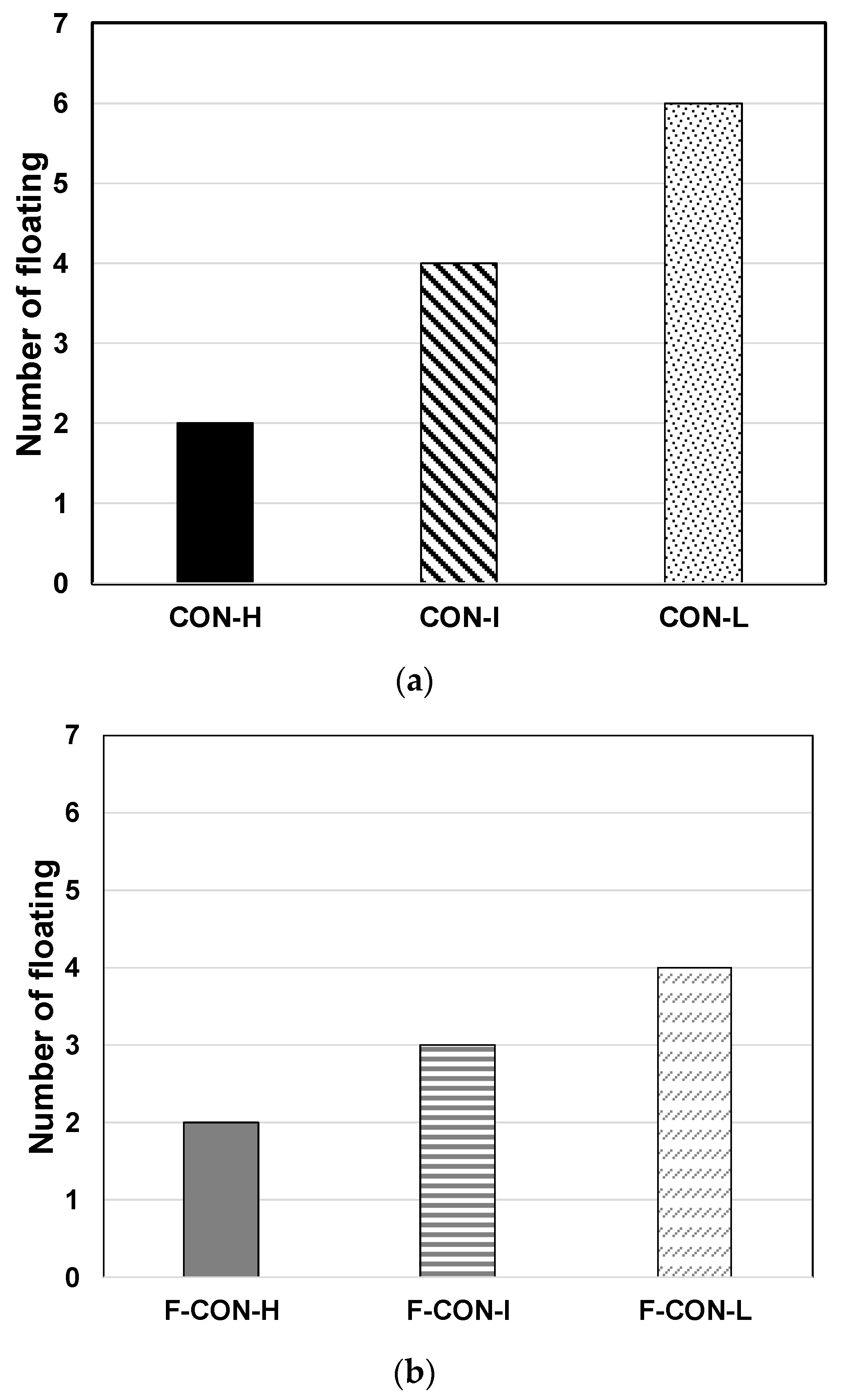

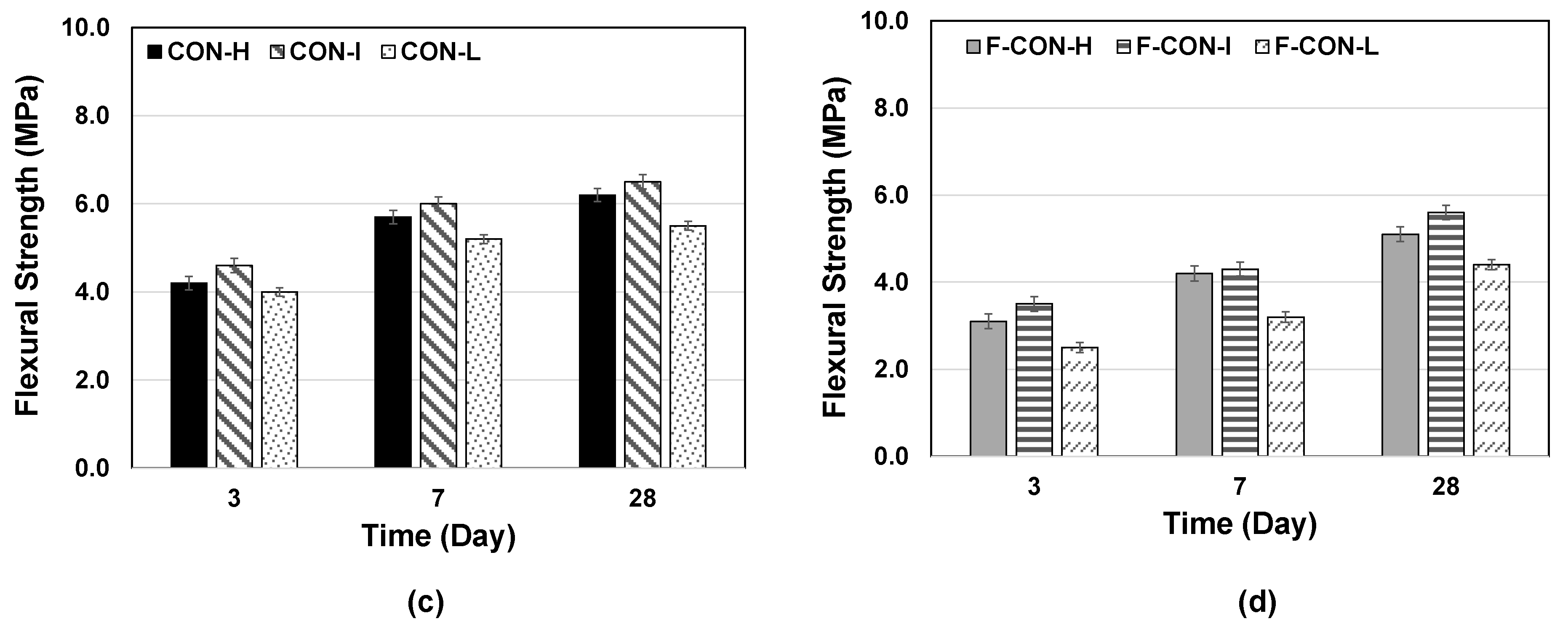

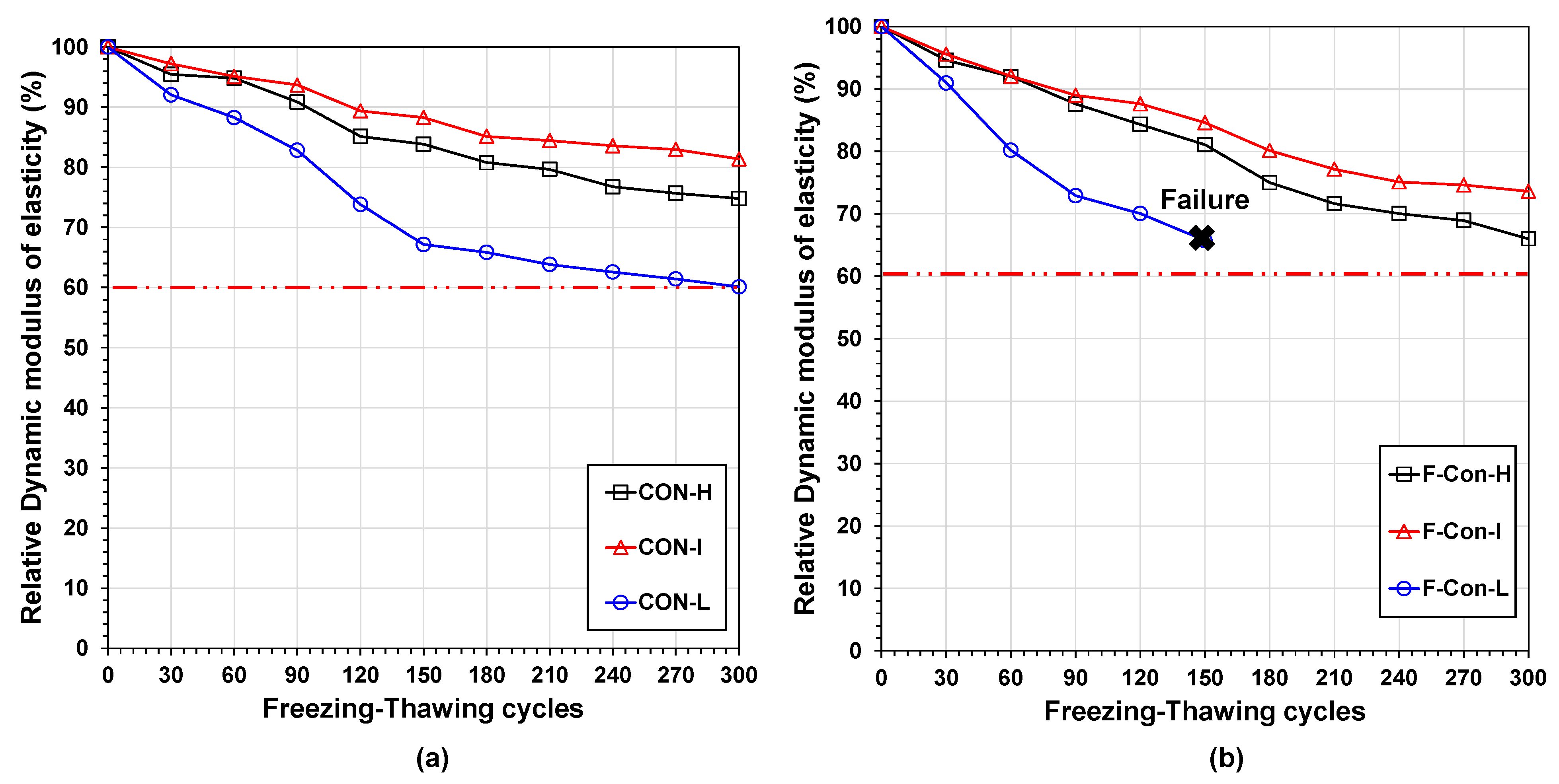
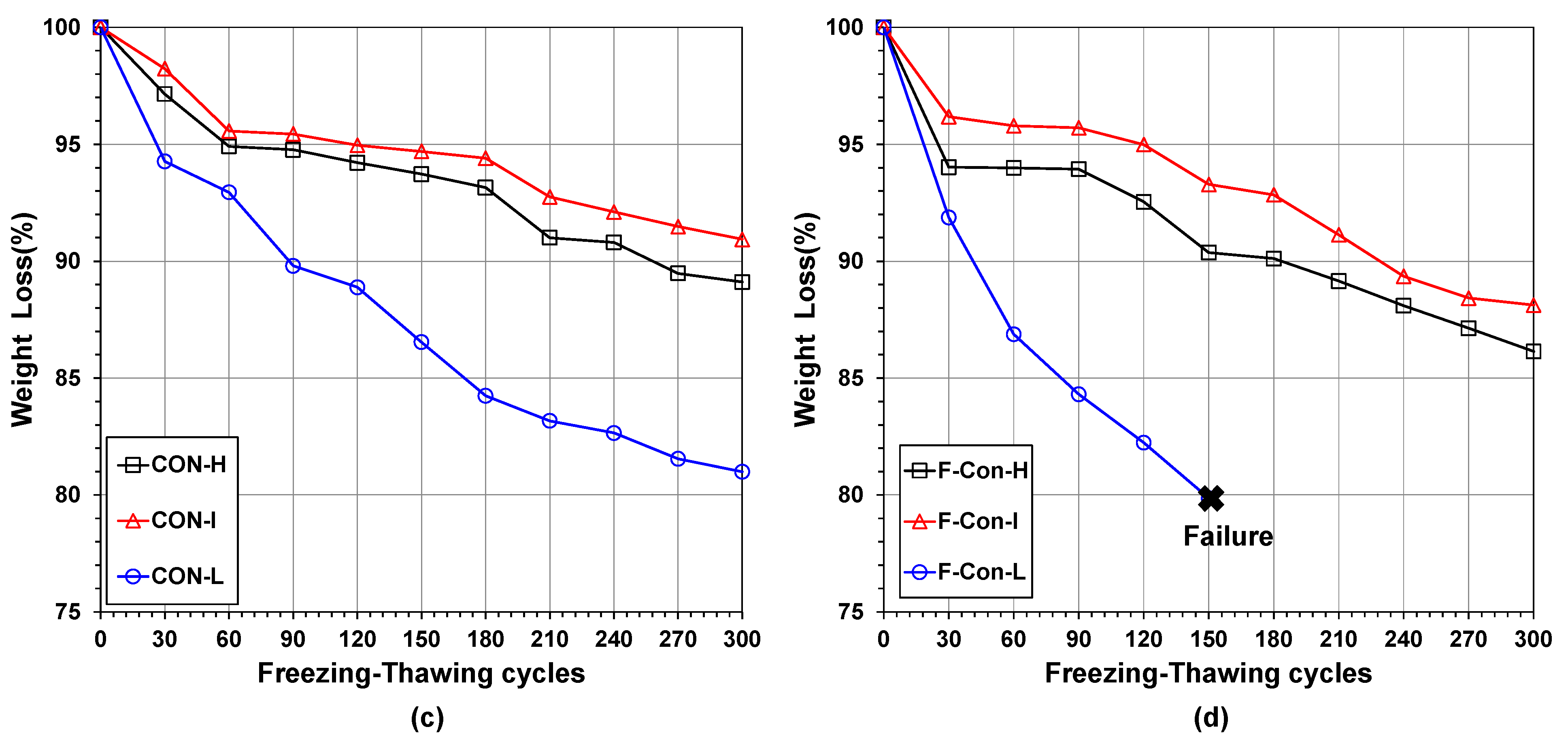
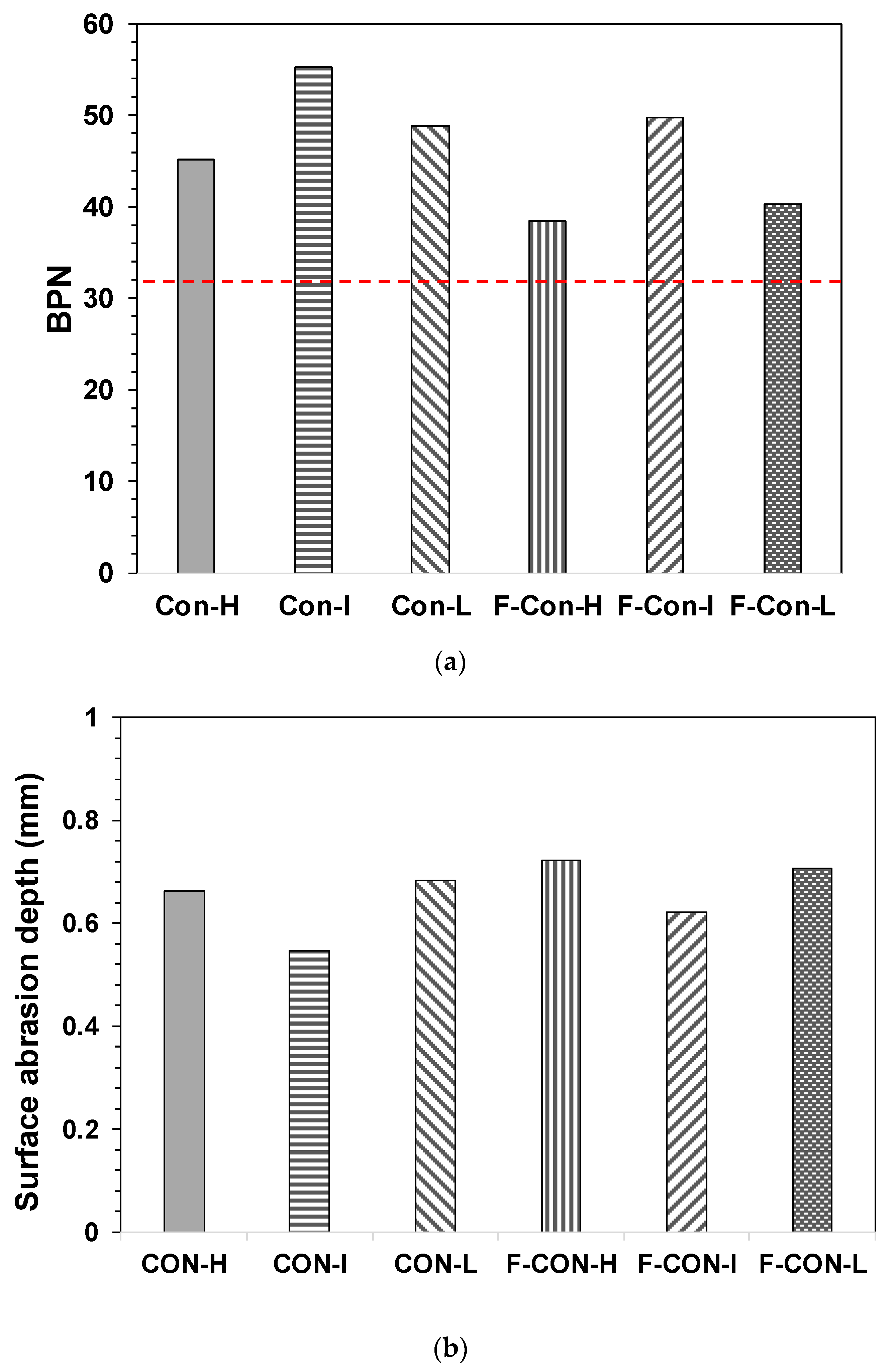

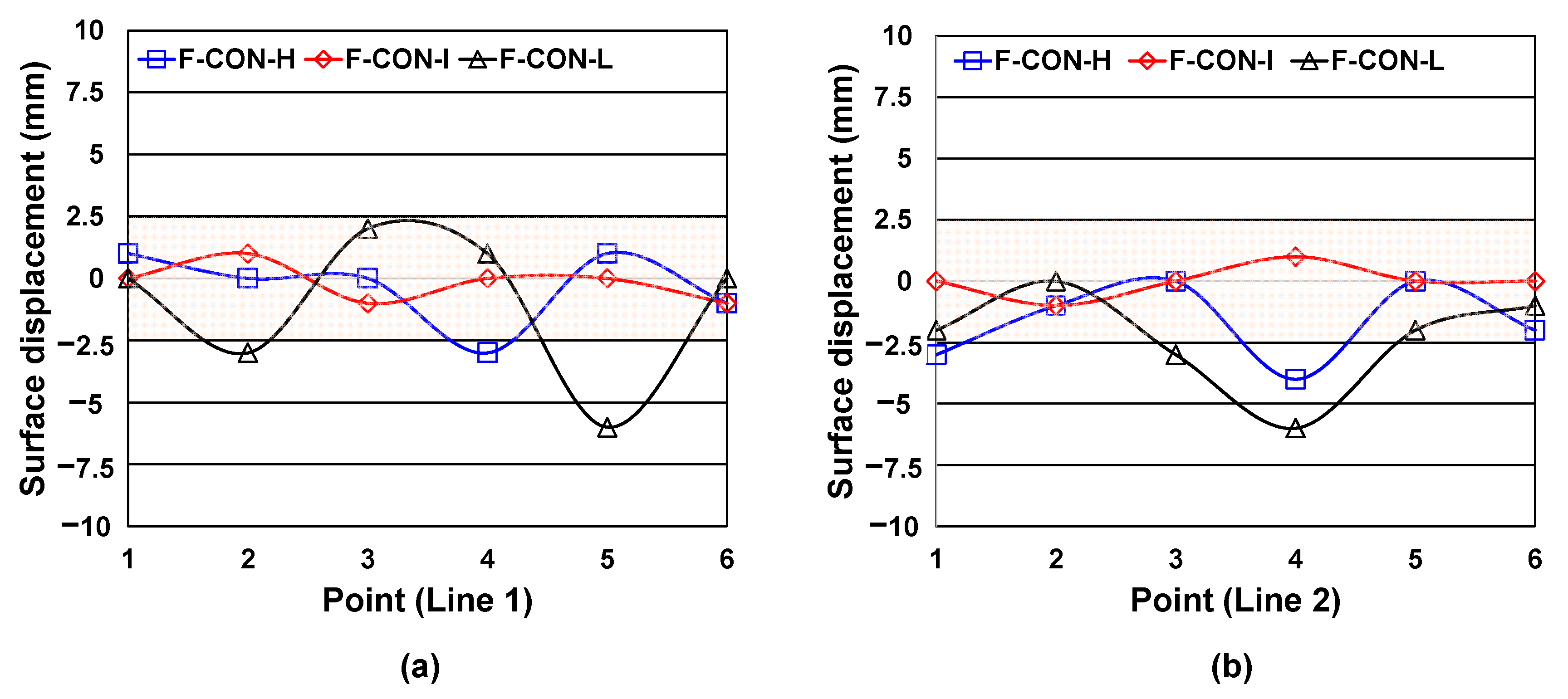
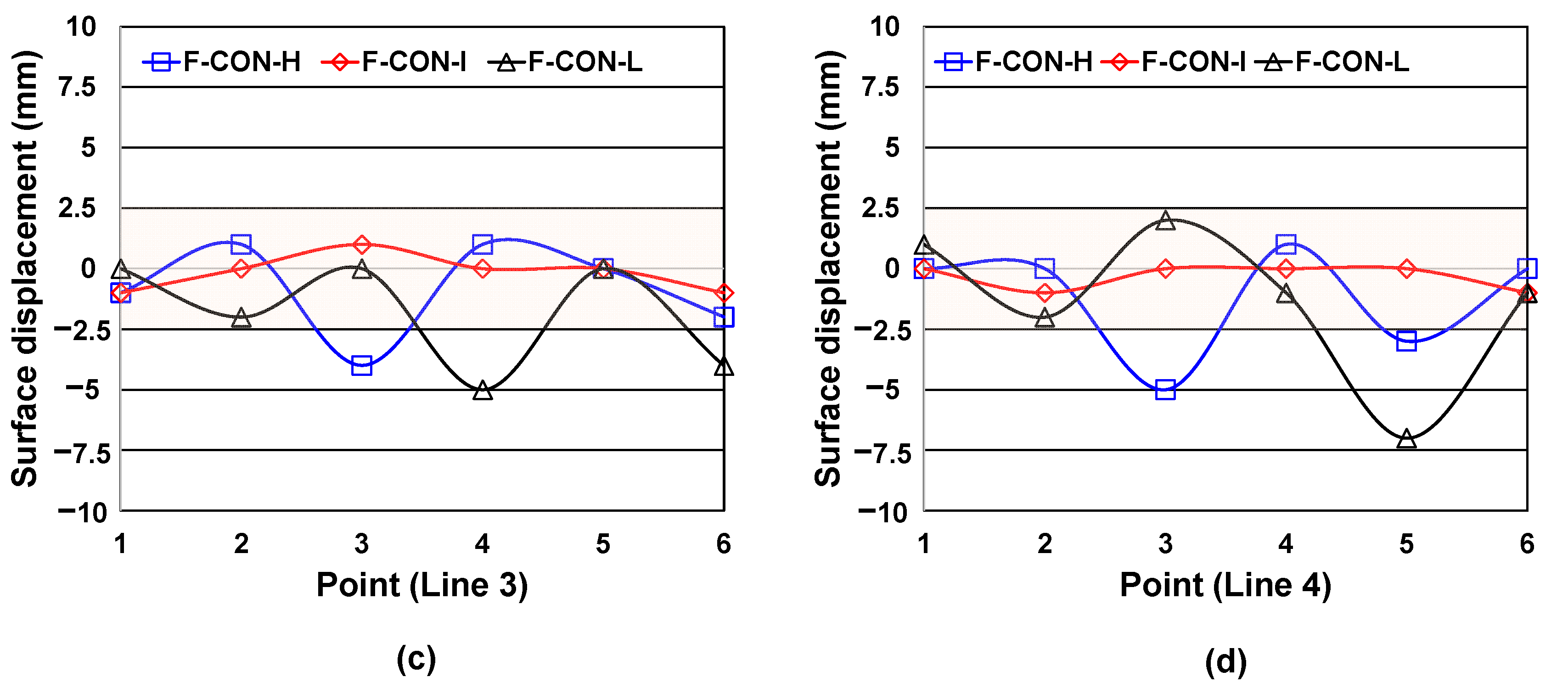
| Oxide | PC (wt%) | FA (wt%) |
|---|---|---|
| CaO | 64.05 | 3.19 |
| SiO2 | 18.59 | 63.65 |
| Al2O3 | 4.45 | 22.38 |
| MgO | 3.14 | 0.68 |
| SO3 | 3.55 | 0.61 |
| TiO2 | 0.29 | 1.16 |
| MnO | 0.19 | 0.68 |
| Fe2O3 | 3.61 | 5.66 |
| K2O | 1.23 | 0.81 |
| Na2O | 0.29 | 0.52 |
| Others | 0.61 | 0.66 |
| Sum | 100 | 100 |
| Sample Group | Sample | Gmax | W/B | S/a | Unit Weight (kg/m3) | ||||||
|---|---|---|---|---|---|---|---|---|---|---|---|
| W | PC | FA | C | F | AE | S | |||||
| CON group | CON-H | 25 | 40 | 40 | 155 | 388 | - | 1052 | 679 | 0.14 | 2.71 |
| CON-I | |||||||||||
| CON-L | |||||||||||
| F-CON group | F-CON-H | 38 | 37.5 | 157 | 331 | 83 | 1061 | 625 | 0.58 | 2.89 | |
| F-CON-I | |||||||||||
| F-CON-L | |||||||||||
| CON Group | F-CON Group | |||||
|---|---|---|---|---|---|---|
| H | I | L | H | I | L | |
| Line 1 | 1 | 0 | 1 | 1 | 0 | 2 |
| Line 2 | 1 | 0 | 2 | 2 | 0 | 2 |
| Line 3 | 2 | 0 | 1 | 1 | 0 | 2 |
| Line 4 | 1 | 0 | 2 | 2 | 0 | 1 |
| Sum | 5 | 0 | 6 | 6 | 0 | 7 |
Disclaimer/Publisher’s Note: The statements, opinions and data contained in all publications are solely those of the individual author(s) and contributor(s) and not of MDPI and/or the editor(s). MDPI and/or the editor(s) disclaim responsibility for any injury to people or property resulting from any ideas, methods, instructions or products referred to in the content. |
© 2023 by the authors. Licensee MDPI, Basel, Switzerland. This article is an open access article distributed under the terms and conditions of the Creative Commons Attribution (CC BY) license (https://creativecommons.org/licenses/by/4.0/).
Share and Cite
Yum, W.S.; Bae, H.E.; Park, H.-W.; Jeong, J.H. Effects of Mixture Proportions and Levels of Vibration on the Physical Characteristics and Durability of Concrete Used in Korean Pavements. Buildings 2023, 13, 2384. https://doi.org/10.3390/buildings13092384
Yum WS, Bae HE, Park H-W, Jeong JH. Effects of Mixture Proportions and Levels of Vibration on the Physical Characteristics and Durability of Concrete Used in Korean Pavements. Buildings. 2023; 13(9):2384. https://doi.org/10.3390/buildings13092384
Chicago/Turabian StyleYum, Woo Sung, Ha Eun Bae, Hae-Won Park, and Jin Hoon Jeong. 2023. "Effects of Mixture Proportions and Levels of Vibration on the Physical Characteristics and Durability of Concrete Used in Korean Pavements" Buildings 13, no. 9: 2384. https://doi.org/10.3390/buildings13092384






